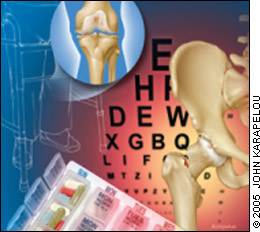
Am Fam Physician. 2005;72(01):12
This issue of AFP presents some new features that are intended to meet readers’ needs and increase the value of the publication. Please feel free to tell us how you like them; you can e-mail us atafpedit@aafp.org or mail the comment card included in every issue.
New Genomics Series
We are pleased to present the first in a series of short reviews on genetic syndromes. The article on page 111 complements the 2005 American Academy of Family Physicians’ (AAFP) Annual Clinical Focus on medical genomics. This series is designed to increase awareness of these diseases so that family physicians can recognize and diagnose these disorders. This first review discusses fragile X syndrome, which is difficult to identify in young children. Also, see the editorial about genetic testing on page 33.
EBM Glossary
On page 11, you will find the new glossary of evidence-based medicine (EBM) and statistical terms. As primary care moves toward evidence-based medicine, we realize that some of the terms used in the literature may be unfamiliar to many physicians. This new glossary will appear in each issue and on the Web site.

Revised SORT Table
The Strength-of-Recommendation Taxonomy (SORT) tables in clinical review articles have been redesigned to set them off as distinct features and to make them more useful to you. In most review articles, you’ll find the table titled “SORT: Key Recommendations for Practice,” which usually will appear on the second page of each article to give you an early overview of the key recommendations found in the article. Also, remember that the two-page full description of the SORT appears in every issue. See page 15 in this issue for this information.
Clinical Evidence Concise
The format of this department is now easier to read (see page 129). The new design should help you quickly identify the treatment options under each clinical question.
Trade Names
In response to many requests, we are now publishing trade names in study summaries in POEMs and Tips from Other Journals. This is for your convenience because we realize that many drugs are more easily identified by their trade names. You need to be aware, however, that trade names used in AFP are the first version of the drug that was released and may not necessarily be the brand of the drug that was used in studies mentioned in Tips, POEMs, case studies, or other articles.
Conflict of Interest Disclosures
At the end of articles that are eligible for continuing medical education (CME) there is a statement indicating whether the author has disclosed any potential conflicts of interest. While the new wording of this statement is a minor change, intended to adhere to revised AAFP policy, I am mentioning it to reiterate AFP’s policy on disclosure. We have procedures intended to identify whether authors have financial relationships that potentially could be considered in conflict with topics they write about. If such conflicts exist, we fully disclose the information to our readers. If a conflict is deemed serious enough by the editor, the article might not be accepted. Our policies and procedures comply with AAFP’s revised policies, which are guided by standards set by the Accreditation Council for Continuing Medical Education to ensure independence of CME activities.
We hope these changes make AFP more useful and readable. Our goal is to continue the tradition of providing the most up-to-date, valuable information for family physicians.